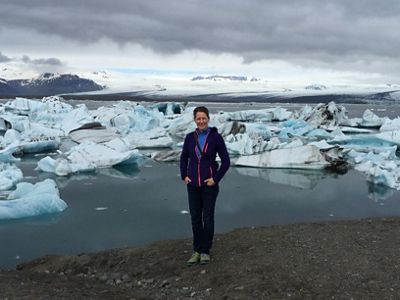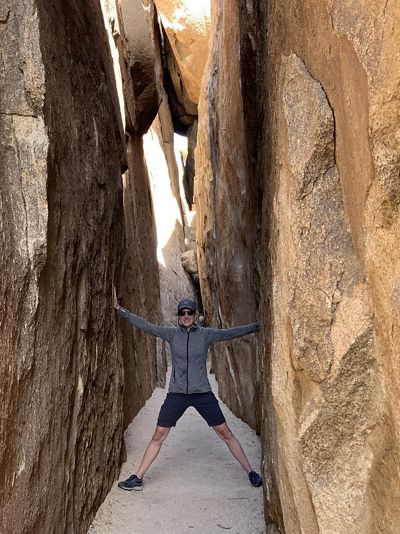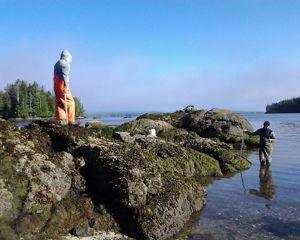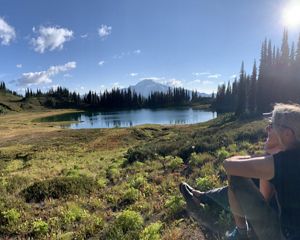Kathleen Hebert
Protecting Puget Sound through activism and investment.
by Anya Blaney, partner, Blaney Consulting

The catastrophic demise of sea stars prompted Kathleen Hebert, a tidepool enthusiast, to start working immediately on the conservation of the waters surrounding her home in the Pacific Northwest. Seeing firsthand the rapidly accelerating effects of climate change, she was determined to battle the threat to sea stars of the haunting “wasting syndrome,” that swept through the delicate coastal ecosystem from Mexico to Alaska.
“I had a shocking wake-up call in 2013,” she said about the experience that brought her to the board of The Nature Conservancy (TNC) in Washington. She visited one of her favorite tide pools with her family and was stunned to see that “all the ochre [purple] stars that covered the stones in the intertidal zone had disappeared in 18 months. It was an epiphany for me because I thought that the world changed on a century basis, not within months.”

Kathleen had already been involved in environmental issues and advocacy as a Social Venture Partners partner since 2003. Now, she “dropped everything” and refocused her full efforts on climate change. In 2015, she became a Northwest Conservation Philanthropy Fellow. The Nature Conservancy recognized her potential as a female leader in environmental philanthropy and sought her expertise for their board. After joining TNC in Washington as a trustee in 2015, she introduced a fresh perspective that prioritized climate change, steering away from a “traditional land conservation approach” and towards mitigating climate change. After nine years, TNC in Washington bids farewell to Kathleen Hebert, as she completes her third and final 3-year term on the board.
“I joined The Nature Conservancy board with a specific interest in climate change, which was a shift from their traditional focus,” she reflected on the organization’s evolution from buying and preserving land to tackling climate change and including Indigenous voices in all aspects of conservation work. “It's so rewarding to see the direction that The Nature Conservancy is taking now, with climate change as the cornerstone of all our work.”
Since accepting TNC in Washington’s offer to join the board of trustees, Kathleen jumped into advocating for climate action locally, nationally, and globally. Within two months of being on the board, Kathleen was chairing the Marketing and Communications Committee. She quickly realized that a multi-level approach was crucial for gaining broad support for environmental projects and policies.
“If you don't have government policies behind them, you can only succeed so far, so I began to focus on advocacy in conjunction with working on nonprofit projects,” she said. Then, in 2016, when the Trump administration began dismantling protections for clean air, water, and wildlife, she realized policy can be ephemeral and understood the need for direct action from business.
She explained, “There are three pillars to my work: nonprofit projects, government advocacy, and for-profit investments because together they have more impact than one could have.”
One project helped her bring together different stakeholders to protect Puget Sound. In 2019, TNC collaborated with the Puget Sound Partnership on the Water 100 Project, a combined effort between scientists, engineers, and conservationists to address the urgent challenges of pollution, development, and climate change in Sound. The project quantifies and ranks the top 100 most effective solutions for improving the region's water quality and building resilience to climate change. Each solution was turned into a pilot project to see how it benefited the watershed. Ultimately, it also demonstrated that scalable, sustainable solutions to Puget Sound's water also help businesses like Boeing avoid disruption.

Kathleen's journey with TNC in Washington encompassed successes and growth opportunities. Not every initiative yielded the desired outcome, but each challenge provided a chance for progress and learning. Kathleen was proud to be involved in Washington Initiative 1631.
“It was a pivotal time for The Nature Conservancy,” Kathleen said. “When we initiated our efforts with 1631, we were in the early stages of learning how to advocate for climate change policies and legislation. I spoke on behalf of the measure with organizations like Boeing and drummed up voter registration on the University of Washington campus.”
She continued, “The degree of collaboration that TNC had with other organizations to get 1631 passed was on a scale that we had never engaged in before; we were all feet on the street for it, and it was incredibly inspiring to see people come together.”
Although 1631 didn't pass, Kathleen could see their efforts paved the path to success. It laid the groundwork for the subsequent Climate Commitment Act (CCA), which the legislature successfully passed in 2021. CCA holds polluters financially accountable while maintaining a pollution cap. The generated revenue and federal investments support climate resilience funds for Indigenous communities, investment in clean energy, and the preservation of natural areas.
“Within two or three years, every policy measure we had hoped for was achieved,” Kathleen recalled. “Though we may not have achieved success with Initiative 1631, the lessons learned from the experience propelled us to exceed our goals through combined legislative efforts in Washington State.”
Outside her work with TNC in Washington, Kathleen also participated in many other environmentally minded organizations. She is a board member of the Clean Energy Transition Institute, a Seattle-based non-profit that provides independent, nonpartisan research and analysis dedicated to accelerating an equitable clean energy transition in the Northwest.
Kathleen is also the vice president and co-chair of the board of directors at E8 Angels and a manager of the Decarbon8 fund, an impact investment organization that focuses on climate technology and sustainability start-ups. Her investments have ranged from zinc anode batteries—which could reduce environmental harm and increase energy capacity—to companies that transform worn-down multi-family units into affordable, green housing.
One of E8’sinvestments, Tidal Vision, derives a biopolymer called chitosan from upcycled food waste such as crab shells, saving them from smothering the ocean floor or emitting greenhouse gasses in landfills. The compound is then transformed into a completely biocompatible and biodegradable solution that can be used as a pollutant-removing water treatment or a non-toxic alternative to traditional flame retardants, fertilizers, and pesticides.
“That’s what I love about impact investing,” Kathleen said. “There’s no one solution to climate change, and with my work, I have a wide range of projects that I can support, each with a different approach to tackling the problems affecting our environment.”

Kathleen seeks diversity of projects and quality collaboration in all aspects of her work, both as an investor and as a TNC in Washington board member. "I joined TNC's board because I wanted to impact the local ecosystem, which can only be truly addressed on a global scale. I love TNC's combination of global scope and tangible local projects."
Kathleen pointed to her work with TNC in Washington to create green stormwater infrastructure on Seattle’s Lake Union. “70% of the pollution flowing into Puget Sound is from stormwater,” she said of the project’s importance. “It runs off our streets and flows unfiltered into the water. It’s causing the Sound to become a desert.”
In the spirit of collaboration with businesses and governments, a developer involved in a new construction project in Seattle reached out to TNC in Washington for guidance on treating water flowing through large downpipes that emptied into Lake Union. This presented a predicament as local ordinances prohibited private individuals from diverting and filtering stormwater.

"It required many sectors to come together to create success,” Kathleen remarked. This collective effort involved TNC, smaller nonprofits like Salmon-Safe, developers, and businesses eager to occupy green buildings once construction was completed. Even the Department of Transportation (WSDOT) had to reconsider its approach to water channeling. Thanks to these collaborative efforts, five out of the seven downspouts beneath the I-99 bridge are now redirected into green infrastructure that naturally filters stormwater before it flows into the Puget Sound. This remarkable transformation exemplifies the power of partnership and innovation in addressing environmental challenges and safeguarding our precious ecosystems.
As she bids farewell to the TNC in Washington Board of Trustees, Kathleen encourages future board members to continue nurturing a collaborative and innovative spirit and to protect the planet through their own actions and their work with others.
“I’ve always been impressed with TNC in Washington’s iterative processes,” she tells future board members. “They learn by doing and then learning again, employing the scientific method for continual improvement, sometimes in small ways, and in very large ways.”
Sign up for Nature News
Sign up to Receive Updates about TNC's Conservation Work around the World



